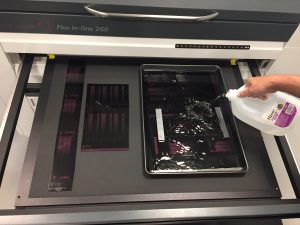TSG Research Project:
Flat-Top Dot Exposure Under Water
General Description
Is there anything else involved or critical to creating a flat top dot other than removing O2 from the exposure process? What happens when exposed under water? Since oxygen molecules are already bonded to hydrogen, we do not expect O2 inhibition (dot sharpening) to occur.
Equipment, Material and Measurement Devices Used
- G&J Flex-in-One 260
- Esko CDI (HD Flexo)
- MAX – 0.067
- Techkon DENS
- Black polyethylene-lined baking sheet
- Distilled water
Process Description
- Imaged two HD Flexo screen targets with tonal scales (149 lpi, 4000 dpi).
- Exposed 1st plate under normal conditions with no O2 barrier (expecting round-top dot).
- Exposed 2nd plate submerged in distilled water (expecting flat-top dot).
- Measured ablated mask tonal values of interest
- Measured tonal values of interest on plate with no O2 barrier – 6% was the first tonal patch to hold due to oxygen inhibition
- Measured tonal values of interest on plate exposed under distilled water – 1% was the first tonal patch to hold
Data and Results
Measured ablated mask tonal values of interest
- 1% patch measured 2% on mask
- 6% patch measured 6% on mask
Measured tonal values of interest on plate with no O2 barrier – 6% was the first tonal patch to hold due to oxygen inhibition
- 1% patch measured did not hold due to oxygen inhibition
- 6% patch measured 1.9% - sharpened 4.1% from the mask
Measured tonal values of interest on plate exposed under distilled water – 1% was the first tonal patch to hold
- 1% patch measured .2%
- 6% patch measured 4.4%
| Percentage | Mask | O2 Presence | Distilled H2O |
|---|---|---|---|
| 1% | 2% | 0% | .2% |
| 6% | 6% | 1.9% | 4.4% |
Summary
While it did not result in true flat-top 1:1 exposure, it did offer benefits over conventionally exposed plate by holding a smaller dot and expanding the tonal range. True flat-top technologies like LUX and ITP (In-The-Plate) would yield even closer to a 1:1 ratio.

